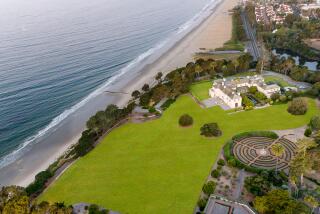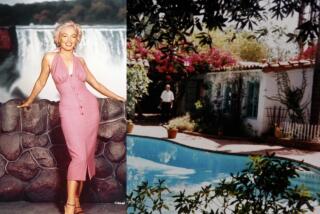The ‘Ladies’ Behind Mount Vernon Restoration : An Unheralded Group of 31 Women Refurbishes Site
- Share via
MOUNT VERNON, Va. — “If George Washington could see his mansion and plantation today, he would be delighted with what the Ladies have accomplished. And, he would feel right at home,” Eugenia Seamans mused.
Seamans, wife of Robert C. Seamans Jr., former secretary of the Air Force, heads a little-known group of a handful of women called the Mount Vernon Ladies’ Assn., owners-caretakers of George Washington’s Mount Vernon estate since 1858.
The Mount Vernon Ladies’ Assn. is the first national historic preservation organization established in America and the oldest women’s patriotic society in the country.
With more than 1 million visitors each year, Mount Vernon on the Potomac River, 16 miles south of Washington, is the most visited historic home in the United States, except for the White House.
Thirty-one prominent women, each from a different state and the District of Columbia, make up the Mount Vernon Ladies’ Assn.
Seamans, from Beverly Farms, Mass., is the regent. The other women are vice regents.
Ever since Ann Pamela Cunningham of South Carolina formed the preservation group, its purpose has been to restore George Washington’s Mount Vernon mansion, furnish it with original belongings of the first President and preserve his estate as closely as possible to what it was when he was alive.
In her farewell address in 1874, when she resigned as founder and first regent a few months before her death, Cunningham renewed the organization’s original pledge “to save the home and tomb of Washington. The mansion and grounds around it should be religiously guarded from change--should be kept as the father of our country left them.”
Cunningham founded the national organization of women in 1853, a few weeks after she sailed down the Potomac River one bright moonlit night. As was the custom then and now, the ship’s bell tolled in respect to Washington when passing Mount Vernon and his tomb.
Miss Cunningham was shocked by what she saw. Washington’s home was crumbling in disrepair.
“Mount Vernon is a disgrace to the nation. If the men of our country will not save it, then the ladies will,” she later wrote in a letter to a newspaper.
Washington, who died in 1799 at age 67, had no children. His wife, Martha, had two children from a previous marriage. When Martha died in 1802, Washington’s nephew, U. S. Supreme Court Justice Bushrod Washington, inherited the 8,000-acre Mount Vernon estate. He had no children, and when he died, his nephew, John Augustine Washington, inherited the plantation.
John Augustine Washington Jr. inherited the property next. The estate was no longer productive. He believed Mount Vernon should be preserved. He tried to sell the mansion and plantation headquarters to the federal government and to the state of Virginia for $200,000. He was turned down.
There was talk, at the time, of making Mount Vernon an old soldiers’ home or a summer home for presidents. But nothing came of either proposal.
That’s when Ann Pamela Cunningham and the Mount Vernon Ladies’ Assn. entered the picture. Cunningham recruited one woman from each of 30 states and the District of Columbia to form the association 134 years ago and to launch a nationwide grass-roots fund drive to buy Mount Vernon.
Five years later, they had raised $200,000 and bought the mansion, the plantation headquarters and 200 acres of the 8,000-acre estate to set it aside as a shrine to the nation’s Founding Father. Today, the Ladies own 500 acres of Washington’s original homestead.
“Once purchased, Ann Cunningham formulated a restoration and accessions policy in 1858 that we still live by today. She set the tone. At that time, nobody else was attempting anything like this. She was a real pioneer as a preservationist,” curator Christine Meadows said.
“The Mount Vernon Ladies’ Assn. opened the doors of the mansion almost immediately after the acquisition, charging 25 cents admission. Few of Washington’s possessions were there in the beginning, the famous Jean Houdon bust of the President, the custom-made globe that Washington ordered from London, the key to the Bastille given to him by Lafayette, but not much more.”
Throughout the Civil War, the Ladies kept Mount Vernon open. President Lincoln declared Mount Vernon neutral ground and Union and Confederate soldiers came here at the same time without one reported incident of violence or bloodshed.
Through the years, the Ladies have amassed an incredible collection of Washingtoniana, generous gifts from Martha Washington’s descendants, from descendants of the President’s brothers and sister, from others and through purchases.
The acquisitions continue to this day. Curator Meadows maintains files on all known Washington items and who owns them. “The Smithsonian has an excellent collection, parts of which are often on loan for exhibit here,” she explained, adding:
“We frequently bid on items offered for sale. Last week, for example, we purchased a novel ‘A Simple Story,’ written by Mrs. Inchbald, probably a pseudonym, as was the practice then, a book published in Philadelphia in 1793. Mrs. Washington enjoyed novels. She had signed the book. It was from her library.”
Today, Mount Vernon is furnished as it was when the Washingtons lived there with numerous original paintings, original pieces of furniture, dinnerware, with the President’s chair and desk in his study, his maps, books, the bed in which he died.
During the last 10 years, all of the rooms in the three-story mansion have been repainted, using 18th-Century formulas and techniques and round paint brushes of that day. Chemical analysis of the first of as many as 22 layers of paint determined the original color, room by room.
Fourteen of the 24 rooms in the mansion are open to the public including the large dining room with a spectacular ornate Palladian window, the room in which Washington was informed he had been named President, the room in which his body lay in state for three days.
“There is this fascination about George Washington,” the curator observed. “People want to see what he owned, the chairs he sat on, the cups he drank from, the looking glass he looked into, the bed he slept in.”
A path from the mansion leads to the 40-foot-long, 40-foot-wide red brick vault constructed after his death. It is built according to Washington’s directions to hold his remains, the remains of his wife and other members of the family.
On a stone tablet over the entrance to the vault is inscribed “Within this enclosure rest the remains of Gen. George Washington.” Directly inside an iron gate are two marble sarcophagi holding the nation’s Founding Father and Martha Washington.
“People are really moved when they look inside the iron gate into the vault and see the marble tomb inscribed ‘Washington’ with an eagle, shield and flag, and the second tomb inscribed ‘Martha, Consort of Washington’ ” said Phil Donnelly, an officer on duty guarding the vault containing the remains of the Washingtons and 25 of their relatives.
On the grounds of Mount Vernon are plantation outbuildings, slave and overseer’s quarters, a spinning house, store houses, stables, laundry, kitchen, smoke house, shops and gardens with the type of plants Washington grew, several trees he personally planted flanking his spacious bowling green.
A museum is filled with Washington memorabilia, including the President’s guns, swords, clothing, and personal items such as the black silk bag to hold his queue, a short braid worn by 18th-Century gentlemen. The Washingtons’ china and silver, examples of Martha Washington’s needlework, her satin wedding slippers, the necklace she wore on her wedding day, and much much more are in the museum.
Nancy Call of Pasadena, whose husband, Richard, is a physician, has been the Mount Vernon Ladies’ Assn. vice regent from California the past three years. California has had a vice regent with the organization since its beginning.
Call served as a California State Arts Commissioner for eight years and is the founding chairman and current chairman of the Friends of Banning Park.
She succeeded the late Elizabeth Kellam de Forest as vice regent from California. De Forest, a horticulturalist, authored the book, “The Gardens & Grounds at Mount Vernon: How George Washington Planned and Planted Them.”
As one of the Mount Vernon Ladies, Call receives no compensation for serving as a vice regent.
“All of us, including the regent, volunteer our time. I pay my own expenses to fly back and forth to Mount Vernon from time to time throughout the year, to attend committee meetings and the annual meeting,” she explained. “It is a great honor to be a member of such a prestigious group of women.”
More to Read
Sign up for The Wild
We’ll help you find the best places to hike, bike and run, as well as the perfect silent spots for meditation and yoga.
You may occasionally receive promotional content from the Los Angeles Times.






